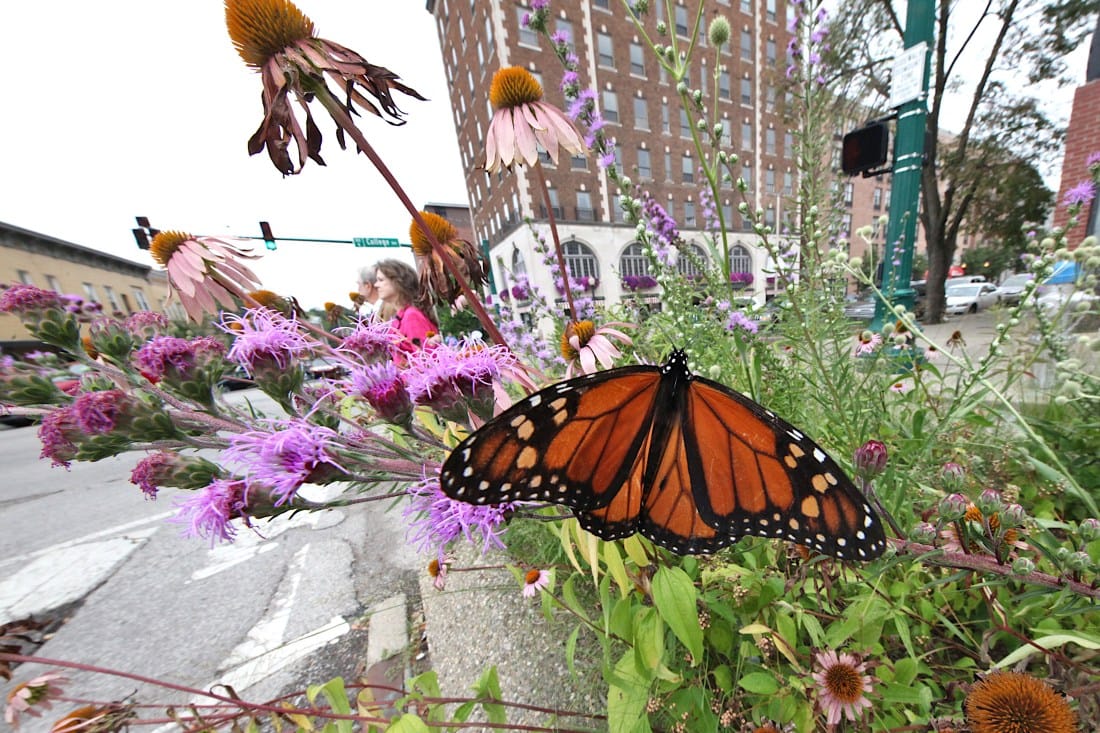Butterfly traffic up in downtown Bloomington

On College Avenue in downtown Bloomington, Indiana, around 11,000 mechanical beasts drive past the northwest corner of the courthouse square every day.
The total for the intersection climbs by a two or three thousand, if the east-west flow on 6th Street is added in.
At that location, a comprehensive traffic count of all God’s creatures would factor in at least a couple dozen extra—to account for the monarch butterflies that have been darting around the intersection in recent days.

The colorful insects are attracted to what Joanna Sparks calls a “contrived environment”—the raised beds of native plants on the corners of the square, which offer butterflies and other insects respite from an ocean of asphalt and concrete.
Sparks is the City of Bloomington’s landscaper. So it’s Sparks who oversees the planting and maintenance of the native-plant beds. She started installing them back when she took the job with the city in 2016. The first three beds went in on the northeast side of the square—so they’d be close to the area on the county courthouse grounds that was already planted with native species.
Sparks told The Beacon that for a landscaper, it’s a choice between decorative annuals, like petunias, or native perennials, which sometimes people mistake for weeds. As a graduate of Indiana University’s School of Public and Environmental Affairs (SPEA), Sparks said her life experience and training frame her thinking along ecologically-minded and holistic lines.
So Sparks has chosen for the courthouse square beds a couple of different kinds of milkweed, prairie drop seed grass, and rattlesnake masters, among several other native species.
How do monarch butterflies migrating south find their way to planter beds in downtown Bloomington? Sparks said it’s a combination of sight and smell, and the fact that they’re constantly looking for fuel. She alludes to “Field of Dreams,” the 1989 film starting Kevin Costner: “If you build it, they will come.”
On Tuesday morning, as a pair of monarchs flirted with each other above one of the beds, Sparks showed The Beacon how the top of a rattlesnake master had been ripped off. It was the casualty of the “vandalism and general hooliganism” that’s a part of a downtown urban environment, she said.
Dog poop, puke and “tons of needles” are part of the detritus that has formed an inherent challenge to urban landscaping, Sparks said. A more recent development is shared-use electric scooters that get dumped in the beds, flattening the plants.
One of the monarchs flying around on Tuesday landed long enough for Sparks to size it up as probably freshly hatched—its wings were unblemished. The monarchs she sees in May, when they’re headed north, are generally pretty “bedraggled,” Sparks said.

The height of the plants in the beds maintained by Sparks has prompted some concern from the city’s planning and transportation department, because of sight-line issues. (Sparks works for the parks department.) A couple of uReports filed by the city’s new after-hours ambassador, Jenna Whiteaker, about 6th & Walnut and Kirkwood & Washington say that the plantings interfere with line of sight.
Whiteaker told The Beacon that Bloomington’s Bicycle & Pedestrian Safety Commission has recommended that the parks department lower the profile of the pollinator garden in the planters at the corner of Kirkwood & Washington.
Mallory Rickbeil, Bloomington’s bicycle and pedestrian coordinator, confirmed to The Beacon that the commission had made the recommendation to the parks department, at its Aug. 12 meeting.
The safety standard for sight lines between drivers is: “The first stopped vehicle on one approach should be visible to the drivers of the first stopped vehicles on each of the other approaches…” Rickbeil said while that standard might be met, the Bicycle & Pedestrian Safety Commission thinks about sight lines for a person who’s three feet tall, standing at a crosswalk.
Rickbeil said the recommendation is not to eliminate the plantings, rather to make them shorter. It will be up to the parks department to decide how to handle it, she said.
Whatever changes are eventually made to the plantings, it doesn’t look like they’ll affect this year’s local monarch population.
The fall’s peak season for monarchs is just starting, Sparks told The Beacon. They’ve turned around in Canada, and started heading back south, and they need to be in Mexico, where they overwinter, before the snow flies, she said.
More than 60,000 sightings of adult monarchs over the last decade have been recorded on the Journey North website. That data is in line with the idea that monarch peak season is just starting. In the Hoosier state, over the years, more sightings have been recorded in September than August.
Some of those sightings were logged by Bloomington residents. On Aug. 31 last year, two monarchs were spotted by Tina Cowden’s class on the playground of University Elementary School.
Monarch sightings in Bloomington can be monitored or recorded on the Journey North website.
Here are a few galleries of photos, taken on different days over the last week or so, on the courthouse square.
Click to view slideshow. Click to view slideshow. Click to view slideshow.



Comments ()